A bamboo cutting board is a valuable addition to any kitchen, serving not only to protect knives from dulling but also to introduce natural beauty to the culinary space. Crafting your diy bamboo cutting board at home is a rewarding endeavor that requires simple materials and tools. In this article, we will guide you on how to make a bamboo cutting board from treated bamboo strips and glue.
Contents [hide]
1. How to make a bamboo cutting board?
Bamboo is a durable, environmentally friendly and easy to care for material, so it is very suitable for making cutting boards. To make a bamboo cutting board, you need the following materials and tools:
- Bamboo sticks are about 40 cm long, 10 cm wide and 2 cm thick. You can buy treated and dried bamboo sticks at hardware or furniture stores.
- A saw, a grinder, a drill and a polisher. You can rent these machines at repair shops or do it yourself if you have experience.
- Ruler, a pencil, a straightedge and a sharp knife.
- Bottle of wood glue, a bottle of glossy paint or oil and a brush.
- Dry cloth, a damp cloth and a piece of sandpaper.
How are bamboo cutting boards made? After preparing, you can start making the bamboo cutting board according to the following steps:
Step 1
At first, make the bamboo stick cut into smaller pieces, with the length equal to the width of the your desired cutting board. You can cut diagonally to create triangular or square bamboo pieces.
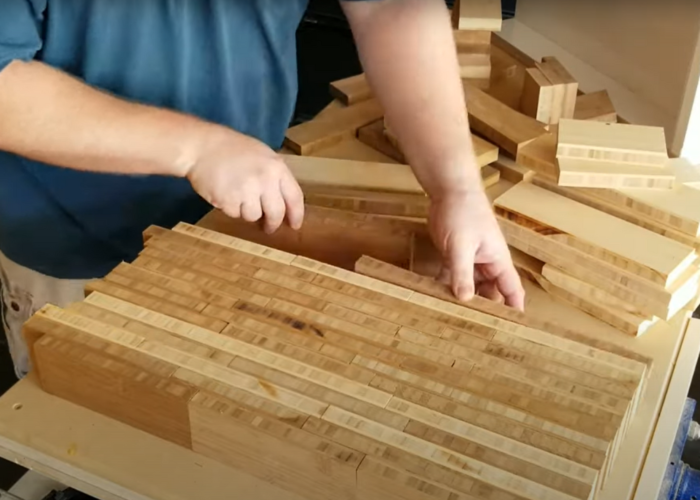
Step 2
Stack the bamboo pieces on top of each other so that the bamboo grains point in the same direction. Use wood glue to glue the bamboo pieces together, forming a solid bamboo sheet. Let the glue dry for about 24 hours.
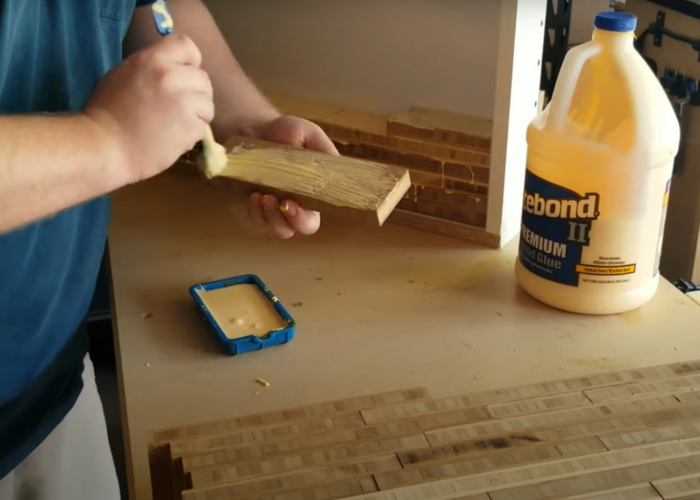
Step 3
Use the saw to cut the bamboo sheet into a rectangle or square, with the size suitable for your needs. You can leave a part of the edge of the bamboo sheet to create a handle for the cutting board.
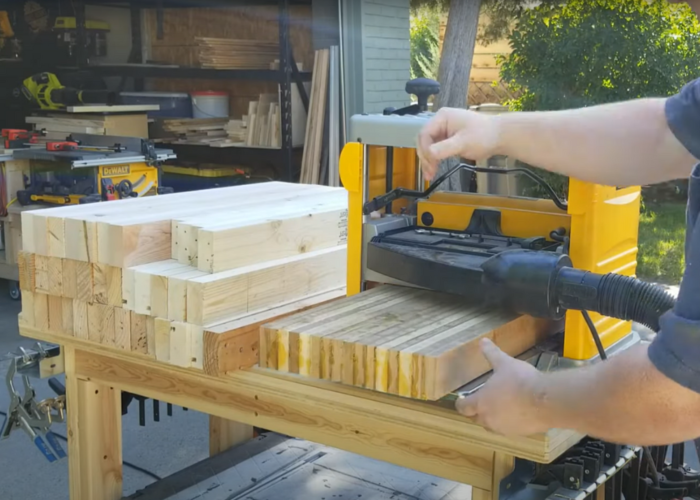
Step 4
Use the grinder to grind the surface of the bamboo sheet for flat and smooth. You should also grind the corners and edges of the bamboo sheet for round and smooth, avoiding scratching your skin when holding.
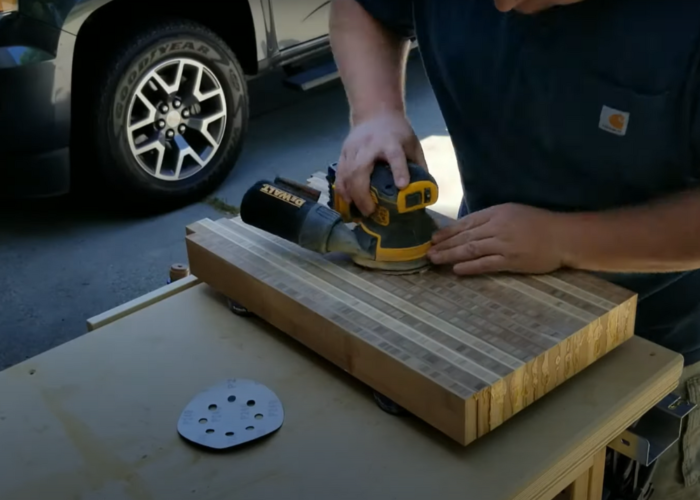
Step 5
Use the polisher to polish the surface of the bamboo sheet to make it shiny and beautiful. You can use glossy paint or oil to increase durability and water resistance for the cutting board. After painting, let it dry for about 12 hours.

Step 6
Use the drill to drill a small hole at the corner of the bamboo sheet or at the handle part. You can thread a rope or string through this hole to hang the cutting board when not in use.
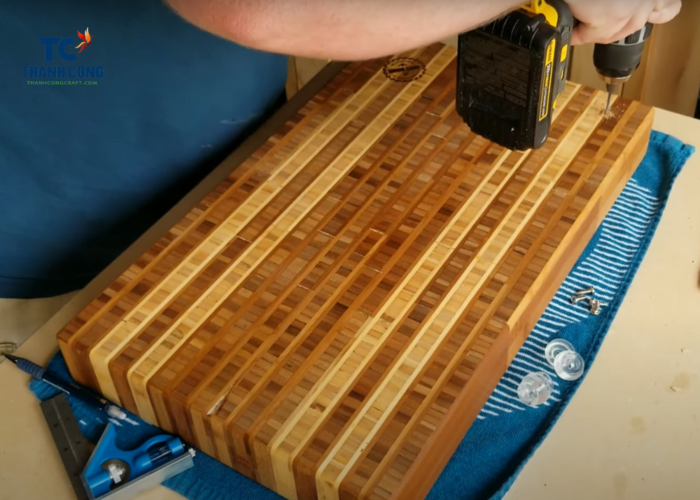
Step 7
Use a dry cloth to wipe away dust from the bamboo board. Next, use a damp cloth to gently wipe the surface of the bamboo board.
Finally, use sandpaper to lightly rub the board’s surface, removing any excess paint and creating a smooth finish, making the cutting board easy to use and slip-resistant.
2. FAQs
2.1 Does bamboo make for a good cutting board?
Undoubtedly, bamboo stands out as an excellent material for crafting cutting boards, offering a range of benefits for kitchen enthusiasts. Renowned for its durability, bamboo provides a robust surface capable of withstanding the rigors of daily knife use without succumbing to excessive wear. Moreover, bamboo’s rapid growth makes it a sustainable and eco-friendly choice, aligning with the principles of responsible living.
Beyond its environmental merits, bamboo possesses natural antimicrobial properties, enhancing the hygienic aspects of a cutting surface. This makes bamboo cutting boards an ideal choice for those who prioritize a clean and safe food preparation environment. The gentleness of bamboo on knife blades also contributes to the longevity of kitchen utensils, maintaining their sharpness over time.
Adding to its practicality, bamboo brings an appealing aesthetic to the kitchen. Its warm and natural look provides an elegant touch that many find visually pleasing. Maintenance of bamboo cutting boards is relatively straightforward, requiring regular cleaning with mild soap and water.
2.2 How long do bamboo cutting boards last?
The average lifespan of a bamboo cutting board is from 5 to 10 years, if properly cared for. To extend the life of your bamboo cutting board, you should clean it after each use with warm water and mild soap, dry it completely before storing it, and avoid soaking it in water or putting it in the dishwasher.
You should also apply mineral oil or vegetable oil to lubricate your bamboo cutting board every month, to prevent bacteria growth and keep it from cracking or warping.
2.3 What are the disadvantages of bamboo cutting boards?
Bamboo is an environmentally friendly, durable and beautiful material, but it also has some drawbacks when used as a cutting board. Some disadvantages of bamboo cutting boards are:
- Bamboo cutting boards can crack or warp if not cared for properly. You need to wash bamboo cutting boards by hand and dry them immediately after use, do not soak them in water or use a dishwasher. You should also use mineral oil or vegetable oil to lubricate bamboo cutting boards every month to maintain moisture and durability.
- Bamboo cutting boards can dull knives faster than other types of cutting boards. This is because bamboo has a long and hard fiber structure, which can damage the blade when cutting. You need to sharpen your knives regularly when using bamboo cutting boards to maintain sharpness.
- Bamboo cutting boards can harbor bacteria if not cleaned thoroughly. Although bamboo has natural antibacterial properties, if you cut different types of food on the same cutting board without washing it well, bacteria can spread and pose a health risk. You should have different bamboo cutting boards for different types of food, or wash bamboo cutting boards well with hot water and soap after each use
2.4 What is the healthiest cutting board to use?
The healthiest cutting board to use depends on personal preferences, needs, and proper maintenance. Here are some common types of cutting boards, each with its own set of advantages:
- Wooden Cutting Boards (Hardwoods like Maple): Hardwood cutting boards, such as those made from maple, are popular for their durability and natural antimicrobial properties. They are less prone to harboring bacteria, and the knife-friendly surface helps maintain the sharpness of blades. Regular oiling is required to prevent drying and cracking.
- Bamboo Cutting Boards: Bamboo cutting boards are lightweight, sustainable, and have natural antimicrobial properties. They are a popular eco-friendly choice. Regular oiling is necessary to prevent cracking, and they should be kept dry to avoid moisture-related issues.
- Plastic Cutting Boards: Plastic cutting boards are lightweight, affordable, and can be easily cleaned in a dishwasher. However, they may develop deep knife grooves over time, providing a potential space for bacteria to hide. Regular disinfecting and replacement when worn are essential.
- Rubber Cutting Boards: Rubber cutting boards are gentle on knives, resistant to bacteria, and can be cleaned in a dishwasher. However, they may be more prone to developing cuts and grooves, requiring proper cleaning and maintenance.
- Glass Cutting Boards: Glass cutting boards are nonporous and easy to clean, making them resistant to bacteria. However, they are hard on knives, leading to quicker blade dulling. The hard surface can also cause chipping of knife blades.
In conclusion, creating a bamboo cutting board at home is a rewarding and sustainable project that allows you to personalize a kitchen essential. By following the step-by-step guide on how to make a bamboo cutting board, you not only contribute to reducing environmental impact through the use of a renewable resource but also craft a functional and unique piece for your culinary endeavors.
If you have any further questions, don’t hesitate to send thanhcongcraft an email us at info@thanhcongcraft.com or message us at WhatsApp: +84967485411. Hope to serve you soon! Best regard!


